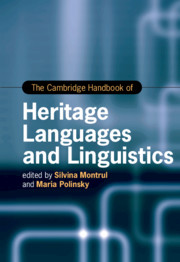Book contents
- The Cambridge Handbook of Heritage Languages and Linguistics
- Cambridge Handbooks In Language And Linguistics
- The Cambridge Handbook of Heritage Languages and Linguistics
- Copyright page
- Dedication
- Contents
- Figures and Tables
- Contributors
- Acknowledgments
- Introduction
- Part I Heritage Languages around the World
- Part II Research Approaches to Heritage Languages
- Part III Grammatical Aspects of Heritage Languages
- 23 Phonetics and Phonology of Heritage Languages
- 24 Morphology of Heritage Languages
- 25 Syntax of Heritage Languages
- 26 Semantics of Heritage Languages
- 27 Discourse and Information Structure in Heritage Languages
- 28 Pragmatics in Heritage Languages
- Part IV Heritage Language Education
- Index
- References
24 - Morphology of Heritage Languages
from Part III - Grammatical Aspects of Heritage Languages
Published online by Cambridge University Press: 04 November 2021
- The Cambridge Handbook of Heritage Languages and Linguistics
- Cambridge Handbooks In Language And Linguistics
- The Cambridge Handbook of Heritage Languages and Linguistics
- Copyright page
- Dedication
- Contents
- Figures and Tables
- Contributors
- Acknowledgments
- Introduction
- Part I Heritage Languages around the World
- Part II Research Approaches to Heritage Languages
- Part III Grammatical Aspects of Heritage Languages
- 23 Phonetics and Phonology of Heritage Languages
- 24 Morphology of Heritage Languages
- 25 Syntax of Heritage Languages
- 26 Semantics of Heritage Languages
- 27 Discourse and Information Structure in Heritage Languages
- 28 Pragmatics in Heritage Languages
- Part IV Heritage Language Education
- Index
- References
Summary
The acquisition, maintenance, and attrition of morphological properties of heritage languages (HLs) has been a central research focus since the inception of the systematic study of these linguistic varieties. Both child and adult heritage language speakers (HSs) experience difficulty in producing target-like inflectional morphology, and in some instances, the errors in their production are similar to those found in the speech of L2 learners. This chapter offers a broad survey of developmental trends of derivational and inflectional morphology in the nominal (e.g., gender and case) and verbal (e.g., agreement, tense, aspect, mood) domains. Different morphological types (e.g., inflectional, agglutinative, fusion, isolating) are discussed, focusing on whether certain properties of heritage morphology are specific to each type and whether certain properties cut across all of them. Claims regarding the effects of maturational constraints and continued activation on the ultimate attainment of heritage morphology are reviewed. This chapter also considers the issue of age effects in connection with heritage morphology and concludes with a brief discussion of the implications that these findings have on linguistic theory as well as highlighting future directions for the study of heritage morphology.
- Type
- Chapter
- Information
- The Cambridge Handbook of Heritage Languages and Linguistics , pp. 613 - 643Publisher: Cambridge University PressPrint publication year: 2021
References
- 6
- Cited by



